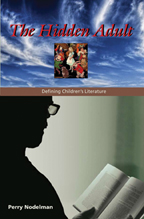Nodelman on the Picture Book Form
 In a recent discussion on Child_Lit, Winnipeg professor Perry Nodelman, author of The Hidden Adult: Defining Children's Literature as well as middle-grade novels, discoursed on the intricacies of the picture book form, particularly in comparison to formal poetry:
In a recent discussion on Child_Lit, Winnipeg professor Perry Nodelman, author of The Hidden Adult: Defining Children's Literature as well as middle-grade novels, discoursed on the intricacies of the picture book form, particularly in comparison to formal poetry:A picture book text is indeed something like a poem, I think--like a sonnet or a villanelle, maybe, because the constrictions of the form are so firm and so complicated.
Feel free to pass this on to any celebrities or new parents who mention they really should take an afternoon and write a picture book for kids.
There are very few words--usually 300 to 600 or so?--to tell a story in. They have to be spread out fairly evenly throughout the book--you don't usually have 500 words on one page and then one each on the rest of the pages. . . . the story itself occupies about ten double-paged spreads. Typically, each one of those spreads contains one discrete section of the text--or possibly two sections, one for each page, dependent upon the shape of the story.
Each of these sections must be discrete and separate enough to stand at least momentarily on its own (as readers stop to look at the picture). But also, each must be incomplete enough to drive a reader onwards--create the suspense that makes someone want to turn the page to find out what happens next.
Furthermore, each must be illustratable--describe something, an action or a person, that a reader might want to see or gain pleasure or information from seeing. And each must be separately visualizable, so that the pictures don’t all look exactly alike. . . .
But--and here’s the key thing that, I suspect, most distinguishes picture books texts from poetry despite their constraints and intricacies--while each section of the text must be visualizable, they must not obviously convey visual info themselves. If they did, they'd render the pictures that are going to accompany them pointless.
So the writer needs to leave space for visuals which are nevertheless going to be a necessary part of the story. And, since in conventional publishing practice illustrators and writers don’t usually work together, it’s the text itself that must convey to the illustrator what the illustrations need to show.
So the text has to suggest to someone prepared to receive it in that way what kind of picture might need to go with it. . . . But on its own, a picture book text is not completely anything yet, any more than a playscript is complete before its performance.
I'd say, then, that a picture book text is more like a playscript than like a poem. Like a poem, a good text is deceptively simple, but complex, intricate, exact and exacting. But unlike a poem, it's not complete without its accompanying pictures. It's an incomplete part of a collaboration.
(Thanks to Chicken Spaghetti for preserving this posting and saving me the trouble of digging into the Child_Lit archives when I found myself thinking about these ideas again a week later.)


1 comment:
thanks for putting this up. It ought to be emailed to every celebrity who ever considers writing one...
Post a Comment